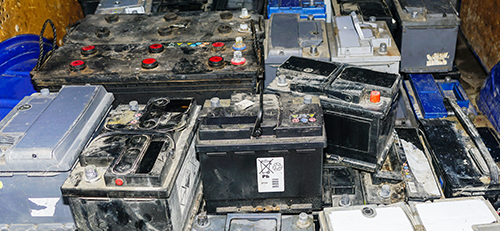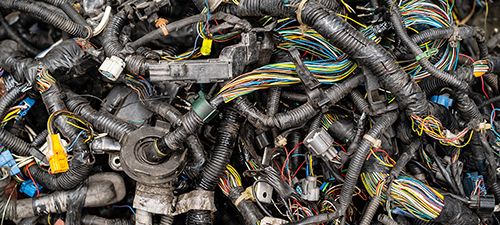P2 Section #2 | Automotive Maintenance - Pg 5

Section 2 | Batteries and E-Waste
Revised On: Feb. 25, 2024 - 9:00 a.m.
Learning Objectives:
- Identify the impact of batteries and e-waste on the environment and human health
- Minimize batteries and e-waste through best management practices
- Determine additional P2 opportunities to reduce batteries and e-waste.
Electronic waste (E-Waste)
Electronic waste, or E-waste, can be defined as discarded electronic devices and equipment, both working and non-working, that have reached the end of their useful life. This includes various electronic items such as computers, laptops, smartphones, televisions, printers, cameras, refrigerators, washing machines, and more. Any electrical or electronic component in a vehicle is considered E-waste. This includes the battery, which provides electrical power for starting the engine, running the electrical systems, and powering various accessories. Car batteries are lead-acid batteries, containing lead plates submerged in sulfuric acid.
Just like the solvents, used oil and various other automotive fluids, many environmental and health impacts result from E-waste. Let’s first discuss the environmental and health impacts that are specific to batteries first.
Batteries

The lead-acid batteries found in cars bring with them many health considerations. Lead is a highly toxic heavy metal that can lead to neurological and developmental issues, particularly in children, and harm adults' cardiovascular, reproductive, and renal systems. The sulfuric acid in these batteries is highly corrosive and can cause severe damage to skin, eyes, teeth, and lungs through exposure to the liquid or vapors. The acid would also be considered lead-contaminated within a car battery, adding toxicity concerns.
Improper disposal of used car batteries can lead to contamination of soil and water sources, posing health risks to wildlife and humans. Lead found in soil or drinking water can be ingested and cause the toxic effects outlined above. Contact with lead can also spread the contamination from one site to another, such as from your workplace to your home. Sulfuric acid entering the environment can cause acid rain, burn plants and animals, and continue to corrode surfaces. Acid rain can have significant adverse ecological effects by stripping minerals or nutrients from the soil and leaching aluminum from the soil. This can then flow into surface waters and cause aquatic wildlife to die if enough is accumulated in their environments.
Proper handling of batteries includes wearing appropriate PPE (e.g., acid-resistant gloves and safety glasses), keeping any ignition sources away, removing metallic objects on your person, and never placing metal objects on top of a battery. The batteries should then be stored indoors, only with other lead-acid batteries, not stacked, and on an acid-resistant surface with secondary containment. These batteries can be sent to be reclaimed off-site. Which will exempt your facility from the applicable hazardous waste regulations as outlined in 40 CFR Part 266 Subpart G. Car battery recycling is crucial to prevent environmental harm and reduce the demand for mining new materials.
Other E-waste

Electronic devices often contain hazardous substances like lead, mercury, cadmium, arsenic, and brominated flame retardants. When e-waste is incorrectly handled, these toxic materials can leach into the environment during disposal or recycling, contaminating soil and water sources. E-waste is sometimes exported illegally to developing countries, where informal recycling methods are used. These practices involve open burning, acid baths, and other hazardous techniques, releasing harmful chemicals into the air, soil, and water. This can affect the health of nearby communities and workers involved in informal recycling.
E-waste contains valuable and scarce resources like gold, silver, and rare earth metals. When e-waste is improperly discarded, these valuable materials are lost. This increases the demand for new mining activities and contributes to resource depletion.
P2 Opportunities
It's difficult to reduce E-waste in an automotive shop as it's service and customer-dependent, similar to refrigerants and antifreeze. However, P2 opportunities can be found by focusing on managing the waste while it is still at your site. This will help reduce waste and benefit your business by improving your environmental impact.
- Proper management and handling of batteries. This will prevent accidental releases of corrosive battery acid and toxic lead.
- Participate in recycling programs that collect and recycle old and used automotive batteries. These programs can help recover valuable materials like lead and reduce the environmental impact of disposal.
Test your Knowledge of P2 | Take a Quick Quiz >
GUIDES
Implementing P2 > | Spanish >
Inventory Control > | Spanish >
Solvent-Contaminated Wipes >
Used Oil >
Waste Determination >
POSTERS
Clear Walkways > | Spanish >
Clean Workspace > | Spanish >
First-In, First-Out > | Spanish >
Use & Stow > | Spanish >
VIDEOS
Auto Shop Housekeeping>
FIFO for Auto Shops >
What is P2 >
OTHER
P2 in Action >
